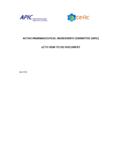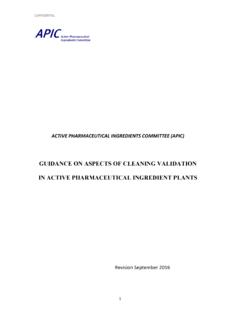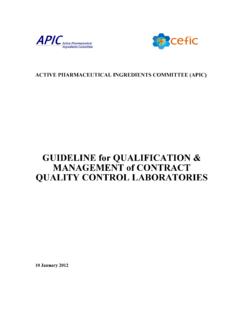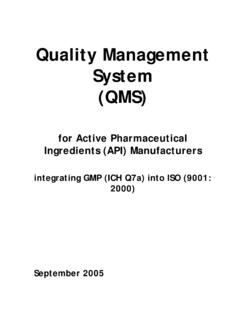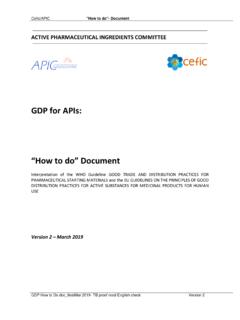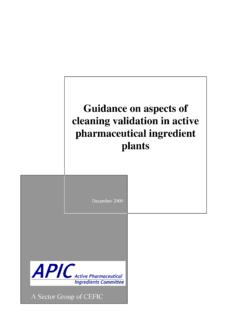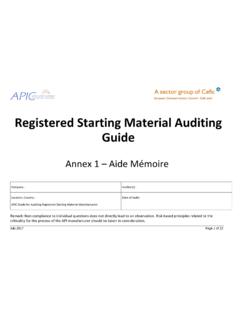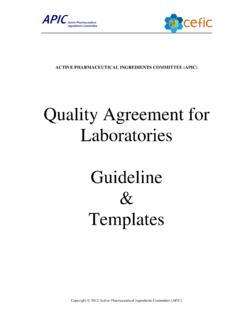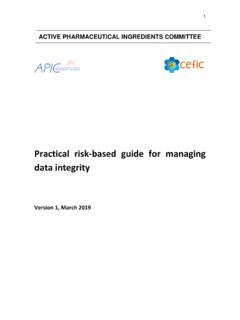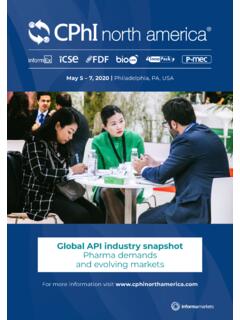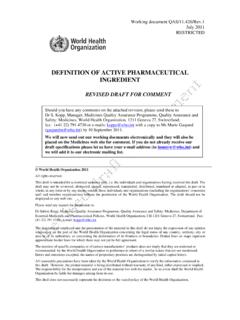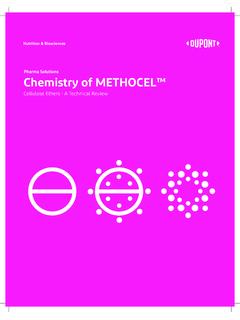Transcription of ACTIVE PHARMACEUTICAL INGREDIENTS COMMITTEE …
1 1 For Internal Use Only Revision April 2019 (updated in February 2021) ACTIVE PHARMACEUTICAL INGREDIENTS COMMITTEE (APIC) GUIDANCE ON ASPECTS OF CLEANING VALIDATION IN ACTIVE PHARMACEUTICAL INGREDIENT PLANTS 2 For Internal Use Only Table of Contents FOREWORD OBJECTIVE SCOPE ACCEPTANCE CRITERIA Introduction Methods of Calculating Acceptance Criteria Acceptance criteria using health-based data Acceptance criteria using a General Limit Acceptance criteria for therapeutic macromolecules and peptides Swab Limits Rinse Limits Rationale for the use of different limits in PHARMACEUTICAL and chemical production LEVELS OF CLEANING Introduction Cleaning Levels Cleaning Verification/Validation CONTROL OF CLEANING PROCESS BRACKETING AND WORST CASE RATING Introduction Bracketing Procedure Cleaning Procedures Investigations and Worst Case Rating Worst Case Rating DETERMINATION OF THE AMOUNT OF RESIDUE Introduction Validation Requirements Sampling Methods Analytical Methods 3 For Internal Use Only CLEANING VALIDATION
2 PROTOCOL Background Purpose Scope Responsibility Sampling Procedure Testing procedure Acceptance criteria Training Deviations Revalidation VALIDATION QUESTIONS REFERENCES GLOSSARY COPYRIGHT AND DISCLAIMER 4 For Internal Use Only FOREWORD This guidance document was initially updated in 2014 by the APIC Cleaning Validation Task Force on behalf of the ACTIVE PHARMACEUTICAL Ingredient COMMITTEE (APIC) of CEFIC. The current Task Force members are: - Ilda Chasqueira, Hovione FarmaCiencia SA, Portugal - Isabel Lopez Monje, Esteve, Spain - Peter Mungenast, Merck KGaA, Germany - Luc Vintioen, Ajinomoto Bio- pharma Services, Belgium - Sven Van Der Ven, Janssen, Belgium - Florent Trouillet, Siegfried Evionnaz, Switzerland - Simon Rieder, Siegfried AG, Switzerland - Frank Stahlhut, Siegfried Minden, Germany - Vartan Hamparsoumian, Seqens, France? - Sofia Riboira, Hovione FarmaCiencia SA, Portugal With support and review from: - Annick Bonneure, APIC, Belgium - Pieter van der Hoeven, APIC, Belgium - Rainer Fendt, BASF, Germany - Jens Brillault, Seqens, Switzerland - Danny De Scheemaecker, J&J, Belgium - Stefaan Van De Velde, Ajinomoto Bio- pharma Services, Belgium A revision of the guidance document was done in 2016 to bring it in line with the European Medicines Agency Guidance on use of Health Based data on setting health-based exposure limits for determining safe threshold values for the cleaning1.
3 The main changes were introduced in Chapter 4, Acceptance Criteria. A further revision has now been done in 2018 - 2019 to address comments received from industry, to align further the guidance with the EMA Q&A2 on use of Health Based Exposure Limits (HBELs) and published articles on use of HBELs. The subject of cleaning validation in ACTIVE PHARMACEUTICAL ingredient manufacturing plants has continued to receive a large amount of attention from regulators, companies and customers alike. 1 European Medicines Agency, EMA/CHMP/CVMP/SWP/169430/2012, Guideline on setting health-based exposure limits for use in risk identification in the manufacture of different medicinal products in shared facilities. 2 19 April 2018, EMA/CHMP/CVMP/SWP/246844/2018, Questions and answers on implementation of risk-based prevention of cross-contamination in production and Guideline on setting health-based exposure limits for use in risk identification in the manufacture of different medicinal products in shared facilities 26 July 2018, EMA/288493/2018, Outcome of public consultation on Questions and Answers on implementation of risk-based prevention of cross contamination in production and Guideline on setting health based exposure limits for use in risk identification in the manufacture of different medicinal products in shared facilities 5 For Internal Use Only The integration of Cleaning Validation within an effective Quality System supported by Quality Risk Management Processes should give assurance that API Manufacturing Operations are performed in such a way that risks to patients related to cleaning validation are understood.
4 Assessed for impact and are mitigated as necessary. It is important that the requirements for the finished manufacturing companies are not transferred back in the process to ACTIVE PHARMACEUTICAL ingredient manufacturers without consideration for the different processes that take place at this stage. For example, higher limits may be acceptable in chemical production compared to PHARMACEUTICAL production because the carry-over risk is much lower for technical and chemical manufacturing reasons. The document reflects the outcome of discussions between APIC member companies on how cleaning validation requirements could be fulfilled and implemented as part of routine operations. In addition, APIC has aligned this guidance with the ISPE Risk MaPP Guide3 that follows the Quality Risk Management Processes as described in the ICH Q9 Guidance on Quality Risk Management. The criteria of Acceptable Daily Exposure (ADE) or Permitted Daily Exposure (PDE) are recommended to be used by companies to decide if Dedicated Facilities are required or not and to define the Maximum Acceptable Carry Over (MACO) of API s in particular, in Multi-Purpose Equipment.
5 Chapter 6 defines factors that should be considered in controls of the cleaning processes to manage the risks related to potential chemical or microbiological contamination. 3 ISPE Baseline PHARMACEUTICAL Engineering Guide, Volume 7 Risk-Based Manufacture of PHARMACEUTICAL Products, International Society for PHARMACEUTICAL Engineering (ISPE), First Edition, September 2010, 6 For Internal Use Only The PDA Technical Report No. 29 Points to Consider for Cleaning Validation4 is also recommended as a valuable guidance document from industry. The following topics are discussed in the PDA document - Cleaning process (CIP/COP): design and qualification - Types of residues, setting acceptance criteria, sampling and analytical methods - Maintenance of the validated state: critical parameters measurements, process alarms, change control, trending & monitoring, training and periodic review - Documentation OBJECTIVE This document has been prepared to assist companies in the formulation of cleaning validation programs and should not be considered as a technical standard but a starting point for internal discussions.
6 The document includes examples on how member companies have dealt with specific areas and issues that arise when performing cleaning validation. SCOPE Six specific areas are addressed in this Guidance document: Acceptance Criteria Levels of Cleaning Control of the cleaning process Bracketing and Worst Case Rating Determination of the amount of residue Cleaning Validation Protocol Finally, the most frequently asked questions are answered to give further guidance on specific points related to cleaning validation. 4 Parenteral Drug Association (PDA) Guidance for Industry. Technical Report No. 29 (Revised 2012) Points to Consider for Cleaning Validation, Destin A. LeBlanc, Gretchen Allison, Jennifer L. Carlson, Koshy George, Igor Gorsky, Irwin S. Hirsh, Jamie Osborne, Greg Randall, Pierre-Michel Riss, George Verghese, Jenn Walsh, Vivienne Yankah. 7 For Internal Use Only ACCEPTANCE CRITERIA Introduction Companies must demonstrate during validation that the cleaning procedure routinely employed for a piece of equipment limits potential carryover to an acceptable level.
7 The limits established must be calculated based on sound scientific rational. This section provides practical guidance as to how those acceptance criteria can be calculated. It is important that companies evaluate all cases individually. There may be specific instances where the product mix in the equipment requires further consideration. The acceptance criteria preferably should be based on the Acceptable Daily Exposure (ADE) or Permitted Daily Exposure (PDE) calculations whenever this data is available. The APIC Guidance refers primarily to ADE in the examples of calculations included in this chapter. The ADE/ PDE define limits at which a patient may be exposed every day for a lifetime with acceptable risks related to adverse health effects. Calculations of ADE/ PDE of APIs and final intermediates are usually done with involvement of industrial hygienists and toxicologists, who review all available toxicology and clinical data to set the limits. The justification of the calculation should be documented.
8 In many cases Occupational Exposure Limits (OEL) will be defined for APIs, Intermediates and Industrial Chemicals by industrial hygienists and toxicologists and the OEL data is then used to define containment measures such that operators are adequately protected while working with the chemicals. For API manufacture preceded by another API, when limited pharmacological/toxicological data is available, preliminary ADE/PDE with available data or TTC approach is recommended. In other cases where availability of pharmacological or toxicological data is limited, for example for chemicals, raw materials, Starting Materials, API intermediates cleaning limits based on the Threshold of Toxicological Concern (TTC), LD50 and/or general cleaning limits may be calculated. In these cases, carcinogenic, genotoxic and potency effect of these structures should be evaluated by toxicologists. The acceptance criteria for equipment cleaning should be based on visually clean in dry conditions and an analytical limit.
9 Unlike in PHARMACEUTICAL production, where residues on the surface of equipment may be 100 % carried over to the next product, in API production the carry-over risk is much lower for technical and chemical manufacturing reasons. Therefore, all the following examples for calculating the limits can be adapted to the suitable situation by using different factors. A competent chemist with detailed knowledge about the equipment and the chemical processes and the properties of the chemicals involved such as solubility should justify this factor by evaluating the specific situation. 8 For Internal Use Only Methods of Calculating Acceptance Criteria Acceptance criteria using health-based data The Maximum Allowable Carryover (MACO) should be based upon the Health-Based Exposure Limits (HBEL), which can be an Acceptable Daily Exposure (ADE) or Permitted Daily Exposure (PDE), calculated when sufficient data is available.
10 The principle of MACO calculation is that you calculate your acceptable carry-over of your previous product, based upon the HBEL, into your next material: HBEL previous x MBSnext x PF MACO = ---------------------------------------- ----- TDDnext x SF MACO Maximum Allowable Carryover: acceptable transferred amount from the previous product into your next material (mg) HBEL Health-Based Exposure Limit (mg/day) of the previous compound MBSnext Minimum batch size for the next material(s) (where MACO can end up) (mg) TDDnext Maximum Therapeutic Daily Dose for the next material (mg/day) PF Purging Factor reflects the ability of a process to reduce the level of the previous product in the downstream synthetic route of the next material (in case the next material is not yet the final API). The default value is 1 unless R&D can provide case-specific purging ability evidence ( in case of control LOD limitation.) SF Safety factor reflects the effects from the interaction between previous product and next material.
